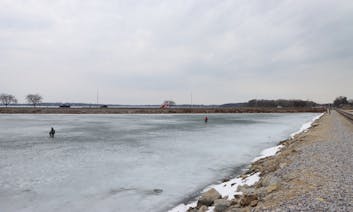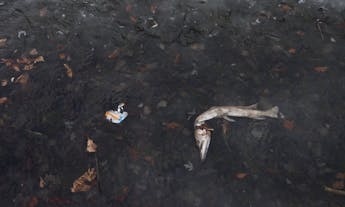As the weather warms and the ice surrounding Madison’s isthmus begins to thin, ice fishermen come from far and wide to cast their line before spring arrives.
But recent news from the Department of Natural Resources may have some fishermen scaling back on fish fries.
Increasingly high levels of the toxic chemicals PFAS (per- and polyfluoroalkyl substances) were found in Monona Bay, a popular spot for recreational fishing for the Bayview neighborhood, according to a DNR report released January 21st. The concentration of PFAS — a group of human-made chemicals used in products such as non-stick cookware and some types of fire foams — was found to be highest in Lake Monona of the lakes in Madison at 7.26 ppt (parts per trillion).
And this buildup of chemicals has affected the entire ecosystem of the lake, including the fish.

A fisherman watches his line.
Stephan Reinke, the general manager of Brittingham Boats, a boat rental service on Monona Bay, has lived in the Madison area for his entire life. He’s been fishing on the bay since 1991, but has stopped eating his catch due to the PFAS build-up.
“Instead of going to after-school when I was in kindergarten in Franklin Elementary, a friend of mine and I would grab sticks with strings and go fish on the rocks by the bay,” Reinke reminisced. “I don’t eat fish out of the bay anymore since [PFAS is] a forever chemical; it doesn’t go away.”
PFAS do not break down in the environment. They bioaccumulate in fish and wildlife tissues, and in the human body. The Environmental Protection Agency has found increased cholesterol levels among populations exposed to PFAS, with more limited findings related to low infant birth weights and effects on the immune system. Cancer has been linked to PFOA exposure and thyroid hormone disruption to PFOS — the most extensively produced and studied PFAS chemicals.
Reinke explained that since Monona Bay is one of the first bodies of water in Wisconsin to freeze over in the winter and one of the last to thaw, it’s become increasingly popular with ice fishermen.
In particular, Reinke said it becomes “Wisconsin’s hottest bluegill pan-fishing spot.”
Winter isn’t the only season that fishers flock to Monona. At any time of the year, you can see fishermen dot the shore of the bay. For some, it's an important source of food. According to Reinke, Monona Bay feeds a lot of the families in the Bayview neighborhood, which is across from West Washington Ave. He recounted how people from the Hmong community fish at night, using illuminated bobbers off of the train tracks that run through the bay.

Despite the dreary weather and dark skies, fisherman still dot the ice over Monona Bay.
In 2019, the DNR confirmed the presence of PFAS foam in Starkweather Creek, which flows into Monona, after department staff spotted the foam forming along the creek near the Olbrich Boat Launch. A water sample taken contained 400 ppt of PFOS with a sample of the foam containing approximately 92,000 ppt. This was the first time foam on Starkweather Creek or Lake Monona had been tested for PFAS compounds.
The fish recently collected by the Wisconsin DNR from June to October in Monona Bay contained up to 110 ppb of PFOS, the Wisconsin State Journal reported. The DHS and DNR advisory recommends against eating fish with PFOS concentrations higher than 200 ppb. The recent health advisory suggested limiting fish intake caught in Lake Monona and Starkweather Creek to one meal of bluegill per week, and any other fish to one meal per month. For pregnant people, the advisory suggests not to eat any fish at all.
But the recommended portion sizes are not nearly enough to fill someone up. Reinke said that to actually have a good meal, he has to eat four or five bluegills in one sitting.
“One bluegill is not enough for anybody,” he stated. “If you ripped a dollar bill in half, and ripped it again lengthwise, that’s the size of filet that you get.”
Bluegills are safer to eat than other fish in the bay because they only live up to five years. Their shorter lifespans mean that they don’t have as much time to accumulate PFAS in their tissue, whereas other fish, such as carp, can live 20 years. A largemouth bass with a lifespan of 16 years that was caught off of Atwood Ave. and tested by the DNR in 2020 was found to contain 180 ppb of PFOS, just 20 ppb shy of the state’s recommended limit. The more of these PFAS-containing fish that people consume, the higher risk of health problems arise, such as higher cholesterol, negative effects on the immune system and even cancer.

As the ice begins to melt around Monona, dead and mangled fish float to the surface.
According to the DNR, PFAS contaminates bodies of water, soil and groundwater in Madison. The Public Health of Madison and Dane County stated that in Madison, known sources of PFAS contamination are the Truax Field Air National Guard Base and the Regional Airport due the use of firefighting foams at their sites, as well as landfills and other businesses and manufacturers.
Although there are multiple sources of the PFAS, much of them are suspected to come through stormwater from the Dane County Airport, where they travel through Starkweather Creek into Lake Monona. The chemicals have been detected in every lake in Madison, but have most severely impacted Lake Monona.
Reinke recalled a chemical fire off of Badger Road in Madison in 2016 where PFAS foam was used to extinguish the fire, and traveled through rainwater into Monona Bay.
“I noticed, and weed harvesters on the bay [said to me], ‘I’ve never seen so many dead turtles in my life. We were scooping them out with rakes and shovels. It was probably 50, 60 dead turtles in the week after that fire,’” Reinke recalled.
The DNR report says that they are currently investigating the sources of the PFAS and working on how to prevent these issues in the future. According to the PHMDC, work is underway with the DNR, Wisconsin Air National Guard, Dane County and the city of Madison to address the PFAS contamination in the water in the area.






